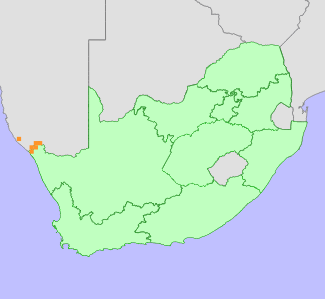|
Scientific Name | Mesembryanthemum tomentosum Klak |
Higher Classification | Dicotyledons |
Family | AIZOACEAE |
Synonyms | Brownanthus pubescens (N.E.Br. ex C.A.Maass) Bullock, Mesembryanthemum buchubergense Dinter ex Range, Psilocaulon pillansii (L.Bolus) Friedrich, Trichocyclus buchubergensis Dinter, Trichocyclus pillansii L.Bolus, Trichocyclus pubescens N.E.Br. ex C.A.Maass |
Common Names | Klein Skerpioenbos (a) |
National Status |
Status and Criteria | Endangered A4ace |
Assessment Date | 2022/07/07 |
Assessor(s) | D. Raimondo, P.C.V. Van Wyk & N.A. Helme |
Justification | A species restricted to the arid regions of southern Namibia and north western South Africa, it has an extent of occurrence (EOO) of 4974 km² within South Africa. There has been a decline of between 30 and 50% of the population as a result of drought related mortality and loss of habitat to mining over the past 15 years and a further 20% of the population is suspected to decline by the year 2050 (generation length 15 - 20 years). This species therefore qualifies for listing as Endangered under criterion A. |
Distribution |
Endemism | Not endemic to South Africa |
Provincial distribution | Northern Cape |
Range | This species has a restricted distribution in southern Namibia, lower Gariep Valley and south east to Steinkopf. |
Habitat and Ecology |
Major system | Terrestrial |
Major habitats | Desert, Succulent Karoo |
Description | It grows in stony ground often on patches of quartz gravel. |
Threats |
| This species is declining rapidly due to the impacts of the worst drought on record which started in 2012 and is still ongoing at the time of assessment. This species is also threatened by opencast mining which is causing ongoing habitat degradation, not just within mining compounds, but all across the surrounding areas due to mining dust blowing over the surrounding landscape and burying dwarf species such as this one. |
Population |
The population has declined by between 30 and 50% due to drought. Many subpopulations in the Gariep Valley have been recorded to experience 100% mortality between 2019 and 2021 especially those restricted to quartz patches along the Gariep Valley (see observations of mortality posted on iNaturalist). However this species can recruit easily if good rainfall is received and it is suspected that there will be a level of recovery of the subpopulations lost in the Gariep Valley, should enough rain be received in the next 10 years. Further to the south east between Umdaus and Steinkopf the species has experienced lower levels of mortality due to drought, only around 30%. There is ongoing decline to the population as a result of habitat loss to mining and ongoing drought related mortality.
|
Population trend | Decreasing |
Assessment History |
Taxon assessed |
Status and Criteria |
Citation/Red List version | | Brownanthus pubescens (N.E.Br. ex C.A.Maass) Bullock | Least Concern | Raimondo et al. (2009) | |
Bibliography |
Klak, C., Bruyns, P.V. and Hedderson, T.A.J. 2007. A phylogeny and new classification for Mesembryanthemoideae (Aizoaceae). Taxon 56(3):737-756.
Raimondo, D., von Staden, L., Foden, W., Victor, J.E., Helme, N.A., Turner, R.C., Kamundi, D.A. and Manyama, P.A. 2009. Red List of South African Plants. Strelitzia 25. South African National Biodiversity Institute, Pretoria.
|
Citation |
| Raimondo, D., Van Wyk, P.C.V. & Helme, N.A. 2022. Mesembryanthemum tomentosum Klak. National Assessment: Red List of South African Plants version 2024.1. Accessed on 2025/10/27 |
 Comment on this assessment
Comment on this assessment

